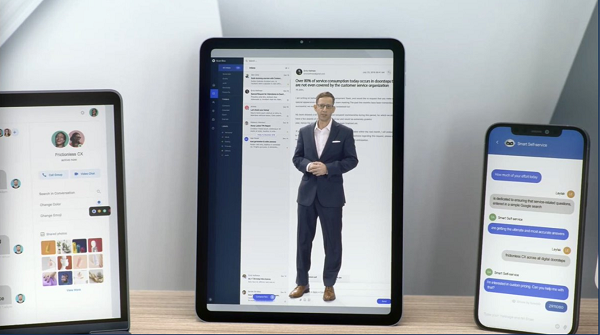What is the metaverse? Seriously, what is it? I admit that I’m extremely confused. It seems “metaverse” is the new “Kleenex” or generic term for anything VR related. Some industry watchers consider any virtual reality platform part of the metaverse, but I think that’s a stretch. Can something be considered part of the metaverse simply because it uses virtual reality? Is there a single metaverse or multiple metaverses? Is it here today or a futuristic concept? These are discussions taking place right now as confusion about the virtual world continues to grow. Like most people, I have so many questions, and there are so many diverging answers.
Much of the theoretical discussion about the metaverse hit home last week when I participated in the NICE Interactions 2022 event in virtual reality using an Oculus Quest 2 headset. I was confused when a couple of speakers noted that we were in the metaverse, as I had assumed that the metaverse is a great concept but won’t be a reality for several years. Was I participating in the metaverse, or simply a really cool and extremely well-done virtual reality event? And does the precise term for the experience matter? Probably not. (and kudos to the NICE event team for an innovative approach and the best keynote I’ve ever experienced. Here are three screenshots from the virtual event and CEO Barak Eilam’s keynote).
The Metaverse and Reality
There are various definitions of the metaverse and little consensus as when it will become a reality or if it already exists. Many articles point out that the metaverse is still a concept. According to the World Economic Forum, the metaverse
is not yet a reality and can’t be identified as a unique product, technology, or service. Authors Stefan Brambilla Hall and Cathy Li have concluded that “we’re still in the conceptual stage of the metaverse.”
According to
Sensorium, “a metaverse is a shared virtual space that is hyper-realistic, immersive, and interactive thanks to the use of augmented reality (AR) and virtual reality (VR) technology. There can be several virtual worlds inside a metaverse, where people can engage in a wide range of activities that are the result of a mix between physical and digital.”
Gartner notes that the metaverse is “a collective virtual space, created by the convergence of virtually enhanced physical and digital reality. In other words, it is device-independent and not owned by a single vendor. It is an independent virtual economy, enabled by digital currencies and nonfungible tokens (NFTs).”
Most people who are writing and talking about the metaverse agree that several technologies comprise it: virtual reality, augmented reality (AR), 3D environments, artificial intelligence, spatial technologies, and a device that provides sensory feedback. Clearly, these technologies currently exist and have gone beyond gaming to business use cases, events, shopping, and more. The NICE Interactions event included all these technologies—so was I in the metaverse?
According to fellow BCStrategies Expert and my go-to source for all things related to AR/VR, Tom Brannen, the NICE Interactions event was in fact “metaverse-y.” Tom explained that “the metaverse is somewhere you go, as opposed to simply joining an online meeting.” He added it could be considered the metaverse when there’s a social or team element that includes exchanging audio and spacial awareness in a 3D environment, so NICE Interactions fit the bill. While a meeting in VR may be considered to be the metaverse, since the meeting platform isn’t attached to others, it doesn't meet the true metaverse definition.
Using the
AltspaceVR platform for live, virtual events, NICE Interactions attendees were able to create their own avatars, move around using a hand controller, see and hear other virtual attendees, and even give them virtual hugs. We could move around the event space (although I somehow ended up in the event space’s basement with a cute dog) and attend live sessions with other attendees. Despite the discomfort of the heavy headset and my lack of agility using the hand controllers (I missed the pre-event training), I was able to get the hang of it and enjoy exploring the event space.
Several things would have improved my experience. I’m an avid note-taker, and it was disappointing that I couldn’t take notes on my computer during the VR sessions, as it would have required removing my headset and putting down the hand controllers (which buzzed and beeped whenever I tried putting them down). I also would have liked to be able to take screenshots of the slides being presented, but I wasn’t able to figure out how to do that (most likely due to user error). During the Q&A portion of one session, it was obvious that the presenter could hear the questions, but as an attendee, I couldn’t hear the other attendee questions. In fairness, this is likely due to a user error on my part rather than a flaw with the event platform.
Looking to the Future
While I couldn’t take notes during the virtual sessions, I expect we’ll see immersive experiences that replicate our workspaces in the near future, enabling attendees to use computers, keyboards, and other tools in virtual environments. The future isn’t too far off: Horizon Workrooms (currently in beta) allows users to switch between physical tools such as controllers and keyboards.
Horizon Workrooms is a mixed reality combination that brings the laptop and desk into VR, enabling up to 16 people to connect to VR and 50 people for the video chat.
Another type of immersive experience, "extended reality" (XR), a combination of augmented, virtual, and mixed reality, will play an important role and will be coming to a conference room near you in the near future. Meetings, conferences, and all types of events will increasingly take place in interactive virtual, 3D environments for both social and business experiences.
Microsoft and Cisco are already leading the way. Microsoft Mesh takes advantage of mixed reality, enabling participants to see, share, and collaborate on persistent 3D content, and offers 3D model capabilities known as Holoportation to "project yourself as your most lifelike, photorealistic self in mixed reality to interact as if you are there in person." According to Microsoft,
Mesh for Microsoft Teams combines the mixed-reality capabilities of Microsoft Mesh, which allows people in different physical locations to join collaborative and shared holographic experiences, with the productivity tools of Microsoft Teams, where people can join virtual meetings, send chats, collaborate on shared documents and more. Leveraging Mesh,
Accenture’s Nth floor metaverse is a virtual campus for people to gather and participate in community events. Accenture touts that 150,000 new hires are working from the metaverse on their first day at Accenture.
Cisco is taking a different approach to immersive collaboration and meetings and announced its
Webex Hologram, a real-time holographic collaboration solution combining Webex meeting functionality with AR hardware to create immersive 3D holograms. Webex Hologram provides “a real-time, photorealistic holographic interaction that goes beyond videoconferencing for a truly immersive experience.”
We’re certainly in early days when it comes to the metaverse, immersive experiences, and extended reality for meetings and business events. Whether we call it the metaverse or something else, immersive experiences leveraging AR and VR are the next step in business communications and will forever change the way we communicate, collaborate, and interact. And I’m looking forward to having a tall avatar with the long legs I’ve always wanted—and I’m looking forward to avatars having legs at all.
This post is written on behalf of BCStrategies, an industry resource for enterprises, vendors, system integrators, and anyone interested in the growing business communications arena. A supplier of objective information on business communications, BCStrategies is supported by an alliance of leading communication industry advisors, analysts, and consultants who have worked in the various segments of the dynamic business communications market.














